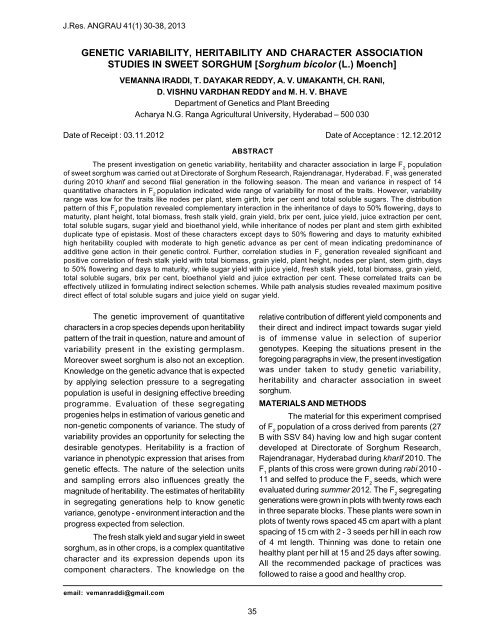The Journal of Research ANGRAU
Contents of 41(1) 2013 - acharya ng ranga agricultural university
Contents of 41(1) 2013 - acharya ng ranga agricultural university
Create successful ePaper yourself
Turn your PDF publications into a flip-book with our unique Google optimized e-Paper software.
J.Res. <strong>ANGRAU</strong> 41(1) 30-38, 2013<br />
GENETIC VARIABILITY, HERITABILITY AND CHARACTER ASSOCIATION<br />
STUDIES IN SWEET SORGHUM [Sorghum bicolor (L.) Moench]<br />
VEMANNA IRADDI, T. DAYAKAR REDDY, A. V. UMAKANTH, CH. RANI,<br />
D. VISHNU VARDHAN REDDY and M. H. V. BHAVE<br />
Department <strong>of</strong> Genetics and Plant Breeding<br />
Acharya N.G. Ranga Agricultural University, Hyderabad – 500 030<br />
Date <strong>of</strong> Receipt : 03.11.2012 Date <strong>of</strong> Acceptance : 12.12.2012<br />
ABSTRACT<br />
<strong>The</strong> present investigation on genetic variability, heritability and character association in large F 2<br />
population<br />
<strong>of</strong> sweet sorghum was carried out at Directorate <strong>of</strong> Sorghum <strong>Research</strong>, Rajendranagar, Hyderabad. F 1<br />
was generated<br />
during 2010 kharif and second filial generation in the following season. <strong>The</strong> mean and variance in respect <strong>of</strong> 14<br />
quantitative characters in F 2<br />
population indicated wide range <strong>of</strong> variability for most <strong>of</strong> the traits. However, variability<br />
range was low for the traits like nodes per plant, stem girth, brix per cent and total soluble sugars. <strong>The</strong> distribution<br />
pattern <strong>of</strong> this F 2<br />
population revealed complementary interaction in the inheritance <strong>of</strong> days to 50% flowering, days to<br />
maturity, plant height, total biomass, fresh stalk yield, grain yield, brix per cent, juice yield, juice extraction per cent,<br />
total soluble sugars, sugar yield and bioethanol yield, while inheritance <strong>of</strong> nodes per plant and stem girth exhibited<br />
duplicate type <strong>of</strong> epistasis. Most <strong>of</strong> these characters except days to 50% flowering and days to maturity exhibited<br />
high heritability coupled with moderate to high genetic advance as per cent <strong>of</strong> mean indicating predominance <strong>of</strong><br />
additive gene action in their genetic control. Further, correlation studies in F 2<br />
generation revealed significant and<br />
positive correlation <strong>of</strong> fresh stalk yield with total biomass, grain yield, plant height, nodes per plant, stem girth, days<br />
to 50% flowering and days to maturity, while sugar yield with juice yield, fresh stalk yield, total biomass, grain yield,<br />
total soluble sugars, brix per cent, bioethanol yield and juice extraction per cent. <strong>The</strong>se correlated traits can be<br />
effectively utilized in formulating indirect selection schemes. While path analysis studies revealed maximum positive<br />
direct effect <strong>of</strong> total soluble sugars and juice yield on sugar yield.<br />
<strong>The</strong> genetic improvement <strong>of</strong> quantitative<br />
characters in a crop species depends upon heritability<br />
pattern <strong>of</strong> the trait in question, nature and amount <strong>of</strong><br />
variability present in the existing germplasm.<br />
Moreover sweet sorghum is also not an exception.<br />
Knowledge on the genetic advance that is expected<br />
by applying selection pressure to a segregating<br />
population is useful in designing effective breeding<br />
programme. Evaluation <strong>of</strong> these segregating<br />
progenies helps in estimation <strong>of</strong> various genetic and<br />
non-genetic components <strong>of</strong> variance. <strong>The</strong> study <strong>of</strong><br />
variability provides an opportunity for selecting the<br />
desirable genotypes. Heritability is a fraction <strong>of</strong><br />
variance in phenotypic expression that arises from<br />
genetic effects. <strong>The</strong> nature <strong>of</strong> the selection units<br />
and sampling errors also influences greatly the<br />
magnitude <strong>of</strong> heritability. <strong>The</strong> estimates <strong>of</strong> heritability<br />
in segregating generations help to know genetic<br />
variance, genotype - environment interaction and the<br />
progress expected from selection.<br />
<strong>The</strong> fresh stalk yield and sugar yield in sweet<br />
sorghum, as in other crops, is a complex quantitative<br />
character and its expression depends upon its<br />
component characters. <strong>The</strong> knowledge on the<br />
relative contribution <strong>of</strong> different yield components and<br />
their direct and indirect impact towards sugar yield<br />
is <strong>of</strong> immense value in selection <strong>of</strong> superior<br />
genotypes. Keeping the situations present in the<br />
foregoing paragraphs in view, the present investigation<br />
was under taken to study genetic variability,<br />
heritability and character association in sweet<br />
sorghum.<br />
MATERIALS AND METHODS<br />
<strong>The</strong> material for this experiment comprised<br />
<strong>of</strong> F 2<br />
population <strong>of</strong> a cross derived from parents (27<br />
B with SSV 84) having low and high sugar content<br />
developed at Directorate <strong>of</strong> Sorghum <strong>Research</strong>,<br />
Rajendranagar, Hyderabad during kharif 2010. <strong>The</strong><br />
F 1<br />
plants <strong>of</strong> this cross were grown during rabi 2010 -<br />
11 and selfed to produce the F 2<br />
seeds, which were<br />
evaluated during summer 2012. <strong>The</strong> F 2<br />
segregating<br />
generations were grown in plots with twenty rows each<br />
in three separate blocks. <strong>The</strong>se plants were sown in<br />
plots <strong>of</strong> twenty rows spaced 45 cm apart with a plant<br />
spacing <strong>of</strong> 15 cm with 2 - 3 seeds per hill in each row<br />
<strong>of</strong> 4 mt length. Thinning was done to retain one<br />
healthy plant per hill at 15 and 25 days after sowing.<br />
All the recommended package <strong>of</strong> practices was<br />
followed to raise a good and healthy crop.<br />
email: vemanraddi@gmail.com<br />
35

















